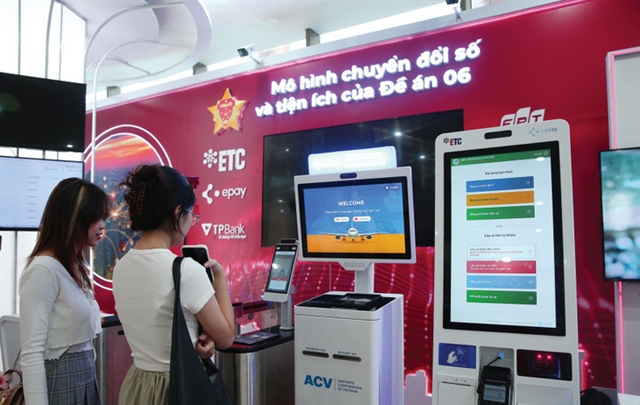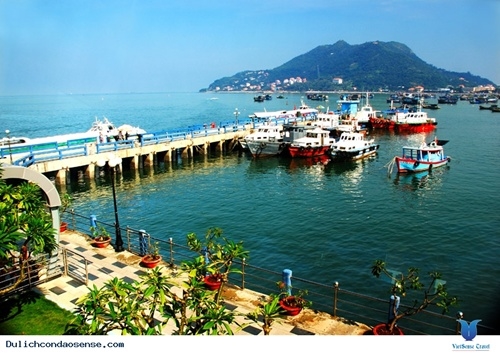 Business Beat
Business Beat

On August 26 the southern province of Bà Rịa-Vũng Tàu issued for the first time municipal bonds worth VNĐ500 billion (US$4.44 million) to raise capital for infrastructure projects. The money will be used for building the Phước Hòa-Cái Mép Road, the Hồ Sông Ray inland canal system, and the Vũng Tàu Polyclinic.
 |
| The southern province of Ba Ria - Vung Tau will build a number of infrastructure projects by capital raised from the local bond issuance. — Photo dulichcondaosense.com |
By Thiên Lý
On August 26 the southern province of Bà Rịa-Vũng Tàu issued for the first time municipal bonds worth VNĐ500 billion (US$4.44 million) to raise capital for infrastructure projects.
The money will be used for building the Phước Hòa-Cái Mép Road, the Hồ Sông Ray inland canal system, and the Vũng Tàu Polyclinic.
The VNĐ100,000 ($4.4) bonds with a five-year tenor were auctioned at the Hà Nội Securities Trading Centre.
The coupon rate after being agreed between the seller and buyers will be fixed over time and paid on maturity.
Those eligible to buy the Bà Rịa-Vũng Tàu municipal bonds range from Vietnamese enterprises and economic institutions to foreign organisations legally operating in Việt Nam, as well as Vietnamese individuals, overseas Vietnamese and foreigners working and living in Việt Nam.
Bà Rịa-Vũng Tàu is among several provinces and cities nation-wide that have in recent years chosen to issue municipal bonds to mobilise capital for development projects to make up for a dearth of public funds.
Investors can buy the bonds and hold them to maturity or trade them on secondary markets. Bonds are often described in terms of their yield, or the interest rate. Thus prices and yields are inversely related to one another.
This new capital source has made significant contributions to socio-economic development in many localities nation-wide.
In 2003-2011 only Hà Nội, HCM City and Đồng Nai issued municipal bonds, raising a total of VNĐ15.7 trillion (US$697.64 million).
Then, in 2012, HCM City and Đà Nẵng issued bonds worthVNĐ4.81 trillion ($213.8 million).
However, the trend really took off in 2013 when many provinces and cities vied with each other to issue the bonds.
The HNX is the exchange that has witnessed the most successful auctions of these bonds in the last few years.
The capital city has issued bonds seven times at the HNX, raising VNĐ11.4 trillion. Đà Nẵng managed to mobilise VNĐ1.1 trillion in October 2014.
According to data from the Việt Nam Bond Market Association, by July 2016 the total value of government bonds, government-guaranteed bonds and municipal bonds in the market was VNĐ880.66 trillion, of which government bonds accounted for VNĐ715.56 trillion.
The government-guaranteed bonds were valued at VNĐ140.59 trillion and municipal bonds at VNĐ24.51 trillion.
The main buyers of municipal bonds have been banks and life insurance companies like VPBank, MB, BIDV, Agribank, Vietcombank, Maritime Bank, Techcombank, LienvietBank, and AIA.
Analysts said the municipal bond market is likely to develop robustly since the government would be unable to meet localities’ funding needs for socio-economic development.
The bonds are a favourite with many investors since they often have more attractive interest rates than government bonds.
Because of this, although the Bà Rịa-Vũng Tàu Province’s issuance of municipal bonds this time was not successful because the interest rate offered by the seller did not match with the rates proposed by the buyers municipal bonds still opened a new opportunity for the provincial government to seek capital for its socio-economic development plans in the future.
So the Bà Rịa-Vũng Tàu government plans to continue going down this route to raise funds for infrastructure projects.
Late August IFC, a member of the World Bank Group, announced a quasi equity investment in the Tiền Phong Commercial Joint Stock Bank (TPBank), which hopes to increase lending to local businesses.
This investment of VNĐ403.1 billion (US$18.35 million) in dividend preference shares, once converted, will allow IFC to become a shareholder in the bank, owning 4.999 percent of the bank’s equity, the institution said in a release Friday (August 26).
With this, TPBank has increased the value of its assets to over VNĐ83.2 trillion and chartered capital to VNĐ5.84 trillion.
According to the IFC, its investment is enough for TPBank to lend to more than 40,000 small and medium-sized enterprises, representing a loan portfolio growth of more than $2 billion equivalent over the next five years.
IFC is also providing advisory services to improve the lender’s risk management, digital and small and medium enterprises (SME) banking products, and corporate governance standards.
TPBank is one of the few lenders to successfully convince foreign investors to part with their money.
Since 2015 many banks have been outlining plans to sell stakes to foreign investors, but their efforts have mostly been in vain.
GPBank is one such. Though the lender was ready to sell 100 per cent stakes, Singapore’s United Overseas Bank (UOB) and Malaysia’s Hong Leong Bank rejected the offer after doing due diligence.
The question is why are foreign investors indifferent to the banking sector.
Analysts said some years ago Việt Nam’s banking sector had been considered highly lucrative, especially by foreign investors.
But it turned out that not all foreign investors were eager, with many apprehensive that since the majority of Vietnamese firms were small and medium –sized enterprises, lending to them was a very risky proposition.
Many were also unsure about banks’ profitability since the bad debts situation was opaque.
Under current regulations, a single foreign investor cannot hold more than 20 percent of the chartered capital of a bank while the combined stakes of foreign investors cannot exceed 30 percent.
The 30 per cent cap is not attractive enough for foreign investors to invest in banks since it would not allow them to participate in management, planning and strategising.
Analysts said however the Vietnamese banking sector remains attractive to banks from other countries in the region such as Japan, South Korea and ASEAN members.
Most want to invest in the Vietnamese banking sector to support companies from their countries operating in Việt Nam.
But another reason that has made foreign investors hesitate is that, faced with integration pressure, the State Bank of Việt Nam would have to throw open the banking sector at some point. This would mean more opportunities for foreign investors to get into banking and finance, including setting up their own banks, which precludes the need to invest in Vietnamese institutions.
Thus, any tie-ups with local institutions would only happen if they are sure about their potential and profitability.
TPBank could persuade IFC to invest money in it since it is small but healthy and possesses all the advantages of a digital bank that would help it to develop well in future.
According to the financial reports of many banks, bad debts seemed to escalate in the second quarter of the year.
The data from nine listed banks showed that their bad debts were worth over VNĐ43 trillion ($1.91 billion), up 28 per cent from the VNĐ33.87 trillion figure recorded late last year.
Eximbank recorded the highest rise in bad debts, going up from 1.86 per cent at the end of 2015 to 5.3 per cent in June, or equivalent to VNĐ4.2 trillion.
To bring down their bad debts, banks have in recent yeas mainly adopted two ways: selling them to the Việt Nam Asset Management Company and sharply increasing credit.
However, both methods are no longer working because the VAMC is now focused on realising old bad debts and has reduced buying afresh.
Banks are also finding it difficult to push up lending since most domestic businesses are still facing difficulties due to the current difficult economic situation at home and abroad.
Faced with the situation, analysts said, banks and their customers should be more flexible in settling bad debts and even have to accept big losses.
SCB seemed to accept this as a fait accompli, settling VNĐ1.2 trillion worth of bad debts in the first half of this year. In May and June the bank sold three fisheries processing plants at prices that were much lower that initially estimated.
The bank hopes to recover a further VNĐ1.5 trillion by lowering the prices of the bad debts.
In addition to banks’own efforts, experts said, the Government and the central bank should have specific plans and road maps for settling the bad debts.
Creating a debt market is an imperative to encourage foreign investors to buy bad debts, they said.— VNS




